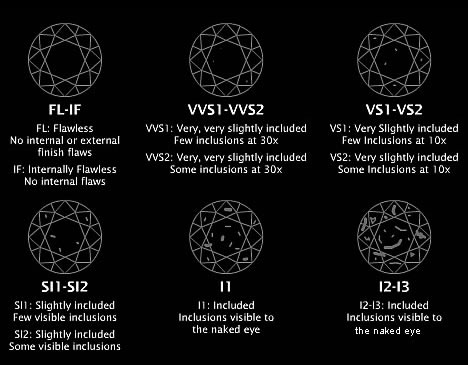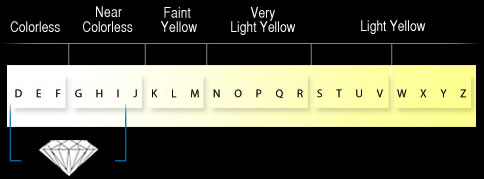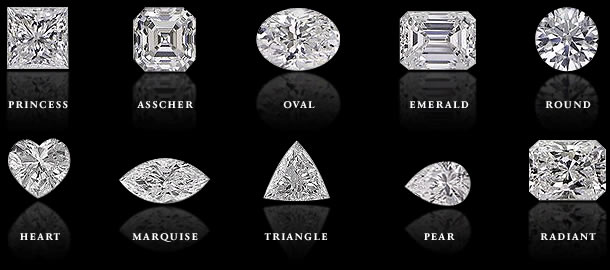Diamond Education
The process of purchasing diamonds can be overwhelming. From carat sizes and cuts to certifications and clarity types, many factors come into play. We have created this Diamond Guide to help you make an educated decision when purchasing diamonds.
Feel free to click on each of the tabs below to learn more about each of the factors involved in purchasing your ideal diamond. When you are ready to begin shopping for diamonds, or if you have any additional questions, feel free to contact our diamond experts at Morgan's Jewelers of Torrance!
Carat
About the Carat Weight
The carat weight measures the mass of a diamond. One carat is defined as 200 milligrams. The point unit—equal to one one-hundredth of a carat (0.01 carat, or 2 mg)—is commonly used for diamonds of less than one carat.
All else being equal, the price per carat increases with carat weight, since larger diamonds are both rarer and more desirable for use as gemstones. The price per carat does not increase linearly with increasing size. Instead, there are sharp jumps around milestone carat weights, as demand is much higher for diamonds weighing just more than a milestone than for those weighing just less. As an example, a 0.95 carats (190 mg) diamond may have a significantly lower price per carat than a comparable 1.05 carats (210 mg) diamond, because of differences in demand. The chart below shows the size of several diamonds compared to their carat weight.

Total carat weight (TCW) is a phrase used to describe the total mass of diamonds or other gemstone in a piece of jewelry, when more than one gemstone is used. Diamond solitaire earrings, for example, are usually quoted in TCW when placed for sale, indicating the mass of the diamonds in both earrings and not each individual diamond. TCW is also widely used for diamond necklaces, bracelets and other similar jewelry pieces.
What Carat Weight Should I Choose?
When deciding which carat weight to choose, there are several factors to consider. For instance, when selecting the carat size for a ring, you should take into account the size of the ring setting and the size of the ring finger. Here are a few other points to consider:
- As we mentioned earlier, the price of diamonds can increase significantly around milestone carat weights, such as at 1.05 carats or 2.55 carats.
- The size of the ring finger can significantly affect the appearance of the ring. For example, a ring placed a size 5 ring finger will appear larger than a ring placed on a size 9 finger.
When shopping for a ring, it is important to know the size of the finger that the ring will be placed on. Once that is known, we welcome you to visit one of our showrooms to compare diamonds of various carat weights for that specific ring size.
Clarity
About Diamond Clarity
Clarity is a measure of internal defects of a diamond called inclusions. Inclusions may be crystals of a foreign material or another diamond crystal, or structural imperfections such as tiny cracks that can appear whitish or cloudy. The number, size, color, relative location, orientation, and visibility of inclusions can all affect the relative clarity of a diamond. The Gemological Institute of America (GIA) and other organizations have developed systems to grade clarity, which are based on those inclusions which are visible to a trained professional when a diamond is viewed under 10x magnification.
Diamonds become increasingly rare when considering higher clarity gradings. Only about 20% of all diamonds mined have a clarity rating high enough for the diamond to be considered appropriate for use as a gemstone; the other 80% are relegated to industrial use. Of that top 20%, a significant portion contains one or more visible inclusions. Those that do not have a visible inclusion are known as "eye-clean" and are preferred by most buyers, although visible inclusions can sometimes be hidden under the setting in a piece of jewelry.
Most inclusions present in gem-quality diamonds do not affect the diamonds' performance or structural integrity. When set in jewelry, it may also be possible to hide certain inclusion behind mounting hardware such as prongs in a way that renders the defect invisible. However, large clouds can affect a diamond's ability to transmit and scatter light. Large cracks close to or breaking the surface may increase the likelihood of a fracture.
Types of Clarity
The image below details each of the six different types of diamond clarity.

What Clarity Should I Choose?
When choosing the clarity of diamond, we recommend you look for a diamond that has no visible imperfections. Typically, these diamonds tend to be an excellent value, as they are far less expensive than internally flawless diamonds (IF), while still appearing flawless to the unaided eye.
When you visit one of our showrooms, we will show you the differences between each type of diamond clarity under a microscope. That way, you can see the exact differences between the various types of diamonds both with your unaided eye and under a microscope.
Color
About Diamond Colors
A diamond’s color refers to the amount of color contained within diamonds. In every diamond, the color is part of the diamond’s composition, and as a result, it will never change. In general, the less amount of color contained within the diamond, the greater the value of the diamond.
At Morgan’s Jewelers, we grade amount of color contained within diamonds using the Gemological Institute of America’s professional color scale. The color scale uses letters D through Z of the alphabet, with D being the high rating and Z being the lowest. The image below displays the entire color rating scale.

What Color Rating Should I Choose?
From the image above, you can see that diamonds rated D through F are colorless, and as a result, tend to be the most expensive. Of course, these diamonds also tend to be the most mesmerizing.
Diamonds rated G through I tend to be an exceptional value. While these diamonds are not as colorless as diamonds rated D through F, they show virtually no color to the unaided eye.
We invite you to visit one of our showrooms to compare diamonds of different types of color ratings in person. Once we learn about your personal preference and the type of setting you would like, we will be able to recommend the perfect diamond for you.
Cut
About Diamond Cuts
The cut of a diamond describes the manner in which a diamond has been shaped and polished from its beginning form as a rough stone to its final gem proportions. We use the cut of a diamond as an objective measure of the reflective qualities of a diamond. In laymen’s terms, the cut of diamond describes how much the diamond sparkles.
It is important to note that the “cut” and “shape” of a diamond are two different characteristics. When we speak of a diamond’s cut, we are referencing the diamond’s reflective qualities. In contrast, the shape of a diamond refers to its general outside appearance.
The diamond cut is often cited as the most important characteristic of a diamond. Accordingly, it is essential to understand exactly how a diamond’s cut affects both its appearance and its cost.
We have included an image below displaying two types of well-cut diamonds. As shown, a well-cut diamond allows light to enter through the table and reflect off both sides, where it then reflects back through the table. The reflection of the light is what makes diamonds so riveting to the observer’s eye.

In contrast to a well-cut diamond, a diamond that is poorly cut will not allow light to reflect through it properly. Instead, the light will enter through the table and leak out through the bottom, rather than reflecting back out through the top. As you may have presumed, the less amount of light reflecting back through the table to the observer’s eye diminishes the brilliance of the diamond. The image below demonstrates how light tends to leak out of poorly cut diamonds.

Why Proportions Matter
Proper cut proportions are essential to a brilliant diamond. At Morgan’s Jewelers, we only select diamonds that are cut using mathematical calculations designed to maximize the brilliance of diamonds.
While the mathematical variations in diamond cuts tend to be very small, they can have a significant effect on the brilliance of the diamond. As a result, all diamond cuts are graded, enabling you to decipher the quality of the cut easily. In general, the grading system is as follows:
- Ideal
- Premium
- Very Good
- Good
- Fair
- Poor
Which Grade is Right For Me?
When selecting the cut grade of a diamond, the choice is ultimately depends on your budget and personal preference. While many factors are involved in the price of each diamond, as you may have presumed, the price of most diamonds rise as the quality of the cut improves.
When selecting the cut grade of a diamond, the choice is ultimately depends on your budget and personal preference. While many factors are involved in the price of each diamond, as you may have presumed, the price of most diamonds rise as the quality of the cut improves.
Certification
Diamond Certificates
At Morgan’s Jewelers, we only sell the highest quality diamonds. Accordingly, all of our diamonds are certified by one of two most reputable certification organizations: the Gemological Institute of America (GIA) and the American Gem Society (AGS).
It is important to note that a certification is not an appraisal. While a certificate provides you with the identity, quality, and characteristics of a diamond, an appraisal places a monetary value on the diamond.
Where are the Certificates From?
While many different organizations offer diamond certificates, Morgan’s Jewelers only sells diamonds with certificates from the Gemological Institute of America (GIA) and the American Gem Society (AGS) — the two most reputable diamond organizations. Both of these organizations have been in operation since the 1930s, and not only have a proven record of upholding the highest ethical standards, but also a sincere emphasis on consumer protection.
To view a sample of a GIA diamond certificate, please click here. (You will need Adobe Reader to view the PDF file.)
Shape
Why Proportions Matter
While most people recognize the classic diamond as round gem, diamonds in fact come in an array of sparkling shapes. At Morgan’s Jewelers, we offer an unparalleled selection of diamonds in a wide variety of shapes. The image below details some of the most popular diamond shapes.

To learn more about each type of diamond shape and to compare the difference in person, please visit one of our nearest showrooms at the Manhattan Beach diamond store.
